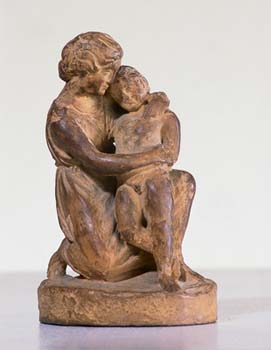Mother and Child
- Late 18th-early 19th century
- Artist unknown
- Terra cotta
13.9 x 7.5 x 8.3 cm., 5-1/2 x 2-7/8 x 3-1/4"
- Catherine Carter Goebel, Paul A. Anderson Chair in the Arts Purchase, Paul A. Anderson Art History Collection, Augustana College 2000.56

Essay by Robert Lopez, Class of 2001
Little background is known about this small, delicate terra cotta sculpture. Its medium consists of clay that is suitable for shaping and firing in a kiln or by direct sunlight. Terra cotta is generally brownish-red in color and consists of combined earth products. Its natural tonality and required shaping and modeling, lend itself to tactile surfaces that invite the viewer's examination and touch. The surface indeed reflects that this is a sculpture that has been lovingly touched by admirers over the years. It has a tradition that can be traced back to early history in both the east and west and continues to be widely used by sculptors and potters today.
The subject portrays the popular mother and child theme that appears throughout various periods and cultures in art history. Probably the most common western tradition for this theme is the Christian subject of Madonna and Christ child. Yet these terra cotta figures wear no halos, symbolizing light emerging from the holy heads of saints. Instead, as is typical of this subject by the late eighteenth to early nineteenth centuries, the period to which this piece is traced, religious subjects became less popular in Europe and were increasingly replaced by secularized versions of maternal bonding. Stylistically, this piece reflects the quiet elegance and classicism of Greek and Roman precedents in vogue during the Neoclassical period.
This sculpture appears to have been carefully hand-crafted rather than mass-produced, as evidenced in the subtle, modeled curves, particularly in the dominant figure's arm as well as in the fine details in general. The drapery of the female figure with its sweeping classical line and interest in the body beneath are beautifully conceived. Note the subtle and carefully crafted anatomical details of the child and the doting attention offered by his mother. She displays an idealized classical profile and her sense of support and touch, reflect the sense of bonding typical of late nineteenth-century works by Mary Cassatt (catalogue 95, 101 and 102). The unknown artist has aptly captured the physical as well as psychological truth of the scene, reflecting a fine master's touch.
